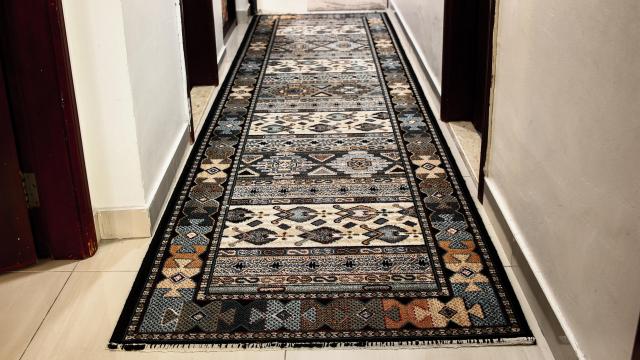Designed to grip your floors and stop your rug from sliding around, the latex rubber that backs a lot of area rugs works really well — until it starts to fall apart and degrade. This can be caused by a lot of things: the cleaning agents you use, moisture and humidity, or simple wear and tear. And when that latex rubber starts to degrade, you’ll find either a fine white powder under your rugs or little bits of rubber stuck to your floors, which can be a pain to clean up. It’s annoying, but if the rug itself is still in great shape, it’s not worth tossing it out because repairing the latex backing really isn’t that hard. Here’s how to do it for about $50 or less.
The cheapest way to fix the rubber backing on a rug
If $30 is too high a price to keep that rug, you might get by just covering up the rubber backing if the deterioration is mostly in the middle portion of the backing. If you have some painter’s tape (or duct tape if you’re not concerned about permanence) and some leftover cloth or even butcher paper or kraft paper, you can cut a piece to fit the underside of the rug, leaving a border of an inch or two around the edge exposed. Tape the cloth or paper in place and flip the rug over; the new covering will stop the rubber from sticking to your floors or leaving that powdery residue, and the edges of the rubber that are still in good condition should still provide at least some grip to hold the rug in place. Your rug will slide around a lot more, but this might keep it in service, at least temporarily.
How to replace the rubber backing on a rug
The more permanent solution is to add a fresh layer of latex to the back of your rug. This is pretty easy — you’ll need four things:
- A can of liquid latex rubber. There are products specifically made to be used as a rug backing, but any liquid latex rubber product will do the job, even Flexseal (though that’s probably not the cheapest option unless you have some left over from a previous project).
- A length of cheesecloth. This isn’t 100% required, but will make the finished project a lot more attractive.
- Scissors, which you probably already own.
- A paintbrush you won’t mind throwing away.
Take your deteriorating rug and brush the back until all loose debris is gone. If there are sections of the original backing clinging loosely to the rug, cut them away until all you have is relatively stable backing. Then proceed with your repair:
- Lay the rug out on top of a dropcloth with the back facing up. Open up your can of latex, mix it well, and start painting it onto the back of the rug. Overlap your strokes and try to get as consistent and smooth a layer as you can onto the rug.
- Cut a length of cheesecloth to almost the same size as the rug, leaving a small margin (an eighth of an inch will do) around the edge so you don’t have cheesecloth poking out from underneath. Lay it on top of the wet latex and press it down into it, then smooth it out using the paintbrush.
- Let it dry for at least 24 hours (48 would be better), then apply a second coat of latex on top. You can apply a third coat if you want, but it’s not absolutely necessary. The cheesecloth is also not absolutely necessary, but it will reinforce the backing and make your repair last longer, so it’s worth doing.
Once your new backing has dried and cured (about two days after the final coat of latex) you can put it back in its place and it should be good as new.

Leave a Reply
You must be logged in to post a comment.